Saturday, March 31, 2007
Title:Zin Es Gourmeden
Artist:Tinariwen
Tinariwen the band from Mali are heavily involved in the Festival in the Desert, a festival for the Tuareg culture that takes place in the Sahara desert each year. This clip from youtube shows the festival being set up, accompanied by the sound of Tinariwen.


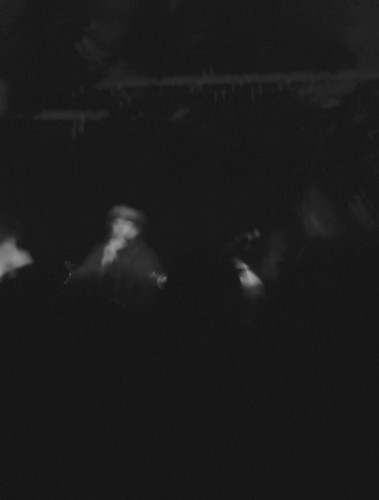
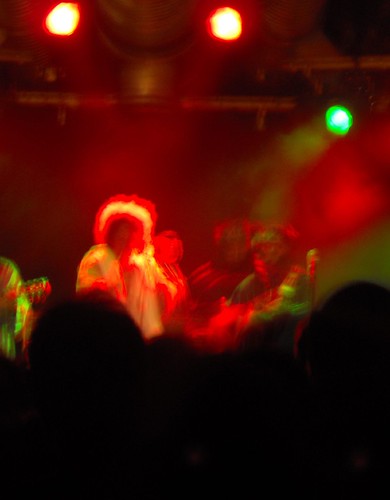
Headliner:Tinariwen
Venue:The Arches, Glasgow, 29th March 2007
Beneath the bridge that comprises Glasgow’s Central Station lie a series of arches, a stretch of which have long been a venue for theatre, live music and clubs. It is here that “the biggest in world music of the moment” took to the stage on Thursday night. With no support, the first member of Tinariwen takes to the stage the back of 8, and he sings a solo song, just him and his guitar. After that the rest of the band join him - 8 people stood on stage, 7 men and a woman - 8 vocalists , at times 4 guitarists, a bassist and a percussionist.
Tinariwen translates as the Tamashek word for “empty places”, the language of the Tuareg nomads of the Sahara desert, of Mali. The band appear on stage in full Taureg dress, robes and headdresses, the men for the most part with veiled faces. Formed in 1982, the band came out of detainment camps for Tuareg rebels, their music is primarily a protest music, sung in French and Tamashek the band sing for independence from the government of Mali, and they are apparently the first Tuareg band to use electric guitars.
The band play for about an hour. The lead vocals switching from person to person according to the track, as do the number of guitarists. The sound is incredibly laid back, an African hybrid of blues and rock, the voices layer with the guitars, and the rhythms of the percussionist sat at the front of the stage with his white veil in place throughout. Even though the music is easy going it has a distinct energy, partly from the density of the sound, partly from the sheer number of people on stage, partly because the crowd are with the band - there are those that close their eyes and let the music sweep across them like grains of sand across dunes, and others who bounce about filled with warmth and energy.
After an hour the band take a 20 minute break, before returning to play a second set of a similar length. Throughout the night the vocals mix, the voice of the woman coming through surprisingly clearly amongst all those men, the rhythms of the words punctuated by periodic ululations of her voice yelping. Various members of the band let the music take them, and they dance, slow ritual motions, the threat of become twirling that never comes for space forbids, building to points where the bassist and one of the guitarists bounce up and down in punk tribal enthusiasm. The crowd roars with enthusiasm in the end, the sound contained and amplified it seems by the brick arches.
Monday, March 26, 2007
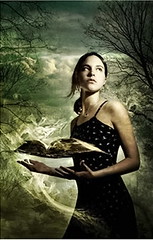
Title:Best New Fantasy
Editor:Sean Wallace
Publisher:Prime
Best New Fantasy is a collection of 16 fantasy stories selected by editor Sean Wallace, most of which fall into a fairly contemporary definition of what fantasy is today. A genre I’m not especially familiar with these days having burnt out on the old clichés. With that the only writers in this collection I was previously familiar with would be Jeff VanderMeer, Kelly Link, M. Rickert and Laird Barron. Reading the collection I was quite impressed by the standard, there weren’t any stories I didn’t particularly like, though perhaps a few that I could take or leave.
The collection starts with Pip And The Fairies by Theodora Goss. Phillipa, Pip, is an actress in a popular soap. But with the death of her mother things change. A writer who did a series of books about "Pip" meeting fairies. Largely forgotten and out of print, there is a sudden resurgence, giving an extra dose of nostalgia. Phillipa quits her job, moves back home and faces up to that extra batch of ghosts.
Joe Hill continues the collection with his piece, My Father's Mask - where Jack wants to spend the weekend hanging out with a guy from school, and more importantly, his hot sister. But his parents have other ideas, and he finds himself in the back of a car heading out to his dead grandad's house in the country. To make it better his mother tells him stories, he is to old for that, but is amused none the less. When they get to the house the rooms are full of masks, and his parents slip on masks and new identities. Things get weird and Jack doesn't know what is going on, but perhaps his mother wasn't telling stories?
Heads Down, Thumbs Up by Gavin J Grant is an odd piece. A breathless fairy tale world, revolving around a kid in a school class, and how as the boundaries of reality flow back and forth affects whether it is a good fairy tale or bad. The story whips passed at such a pace, all wondrous and dizzying, so that it is finished before you realise that you don't actually know what just happened.
Eugie Foster’s Returning My Sister's Face is probably one of the most "traditional" pieces in the collection, with that it is possibly also one of the least interesting in this context, though not actually a bad story. A samurai warrior betrayed, becomes haunted by his dead sister, who extracts a promise of revenge from him. Leading to spectral visions, drunken samurai, and classic ploys and shenanigans as each side tries to out trick the other.
The Farmer's Cat is a timeless fairy tale by Jeff VanderMeer. Set in Norway, a farmer finds himself plagued by an annual infestation of trolls. Which looks set to destroy his life, his family have left him, the trolls are ruining his land, and they have even eaten his cat! But when he gets a new cat from a travelling salesman the tables are turned, honour and promises are important even to trolls, and trickery is at work.
With A Very Little Madness Goes A Long Way , M. Rickert establishes some interesting ideas, but in the end, for me, it just kind of fizzles out. A couple move house after the death of their daughter, but the crows seem to have followed them, to be watching them. The woman's brother is on his way to see her, to reveal that she isn't what she seems, when he has an encounter with a dark force. After that, things get nasty, there are deaths all over the place, and it would appear that there is no hope. Ending the piece during the darkest phase would have left it feeling ambiguous, and it would have made some sense. But instead the ending which is extracted feels a little hollow, ambiguous still, but even more confused.
Christopher Barzak’s The Language of Moths is one of the most magical stories in the collection, with a really nice use of language. The story alternates between two points of view - a brother and sister. There parents take the pair away to a cabin in the woods, their father desperate to restart his career by finding a rare moth that he remembers seeing as a child. The trips changes both their lives. The boy is 14, and always left to take care of his sister by his overly distracted parents, though when he is given a chance to get spend sometime on his own he takes it, leading to his first sexual experience, with another boy. The sister is 17, and autistic, her brother is an intense old man to her view, who she can't communicate with, however the realisation that she can understand the language of moths changes everything.
In The Dybbuk in Love by Sonya Taaffe, a young woman called Clare meets a wandering spirit from Jewish legend - the Dybbuk. A spirit who has fallen in love with her, who she can see taking possession of those around her. One minute she’ll be talking to a stranger, the next their entire persona changes, and it is clear the Dybbuk has taken them for a moment, breaking through to court her again. By turns she is inspired by his knowledge, fascinated by his charm, and unsettled by the whole experience of encountering the restless spirit.
Gulls by Tim Pratt is one of the shortest sharpest little stories in the collection. A woman takes her bored nephew away from the rest of the family, headed towards the beach, where the pair have a strange and distressing encounter. One of those pieces which could probably be more adequately be described as a horror story than a fantasy. The Maiden Tree by Catherynne M. Valente is another short piece. An updating and grungification of Sleeping Beauty, taking things to a darker extreme. One of the pieces I was less keen on, on the whole.
Laird Barron provides another piece which probably tips more into horror than fantasy with Proboscis. Ray, keen to kick start his TV career, tags along with his ex-brother-in-law Cruz on a bounty hunting trip. The capture is tough and gets messy after that anyway, depressed by these events he isn’t thrilled when Cruz takes a detour for a little known tourist attraction and drink. However when he makes his own way to the attraction after an argument and as night falls, he starts to become uneasy, there is something in the darkness.
Yoon Ha Lee’s Eating Hearts has parallels to Eugie Foster’s in that they both have that traditional oriental myth feel. Eating Hearts is a little more “fantastic” than Foster’s “ghost story” though. A young woman, Horanga is after the perfect magician, and Chuan is the latest in her strings to find one. Their conversation is a little flirtatious, as they spar over definitions of magic and of perfection. Chuan proves something of his ability, discerning along the way that there is more to Horanga and her search than initially evident. A tricky little story. Followed by the brief and dream like Dancing In The Light of Giants, contributed by Jay Lake, a little girl dances for her elders. Young and full of life she dances for the giants, knowing one day she will be one of them.
Kelly Link is a tricky and master of the short story, and Monster is certainly a good example of what she is capable of. School camp, and the boys of Bungalow 4 are running out of time to do their camp out. They are rather reluctant to do so, especially after Bungalow 6 claim to have encountered a monster when they were camping out. Monster is filled with the fun and games of child hood, the pecking order, the kids who are being bullied, the experience of summer camp. Which is all good and well, and lots of fun, but when the boys go out, they are unprepared for what they encounter.
At The End of The Hall by Nick Mamatas is a hard one to pin down. A woman lies old and weary in a hospital bed, life hasn’t quite worked out as well as she had hoped, her family are something of a disappointment. Lying there her head is full of thoughts, of the giant robots from the cover’s of her brother’s science fiction magazines when they were kids, to the power of wishes. All her life she has resisted making wishes, not because she doesn’t believe in the power of the wish, but because she has seen so many wishes frittered away on silly things. Here and now, perhaps it is time, at last for her to make a wish?
To a degree Summer Ice by Holly Phillips is the least genre orientated of the entire collection, and it does beg the question of how it qualifies to be in a fantasy collection at all. Though it certainly has a charm, and I enjoyed it more than some of the more blink and you miss it pieces that are included. Manon has just moved to a new city, taken on as a young instructor at the art school. She has been given praise for her talent, but she is less than confident about that, let alone actually knowing how to teach other young people to become artists. She keeps herself busy, works with the other residents of the block of flats on the new roof garden their land lord has allowed them to have, works with a volunteer group in the community to clear waste ground. But it is in the ice cream shop that she visits as often as she can, tempted by the sweet treat in the hot weather, that she finally starts to become inspired.
In reflection I think I would pick out My Father’s Mask, The Farmer’s Cat, The Language of Moths, The Dybbuk in Love, Monster and Summer Ice as the stand out stories, those which I enjoyed the most in this collection.
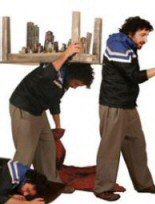
Title:Mr. Sole Abode
Company: Madrugada
Venue:Lyric Hammersmith, London, 17th March 2007
Mr. Sole Abode is the first piece of physical theatre from the new Madrugada theatre group. A one man show by Leo Kay, about the character Mr. Sole Abode who lives in a fridge in the street. As the piece starts Sole is already in the fridge on the limited performance area. With dawn, he crawls out of it, agonises to stand up straight after such a confined position, one of the drawn out and repeated pieces of humour through out the performance. Spotting his audience he regales us with wonderful tales of his life. Mr. Abode is passionate about his food, even if he exists now on scraps of bread he toasts over his disposable lighter. He drools at the mouth telling us about the food he has eaten, the food he has prepared. Through the play he starts each monologue with his thoughts on food, gradually working round to his career as an architect. He boasts about some of the wonders he has designed, then some of the projects he has been asked to contribute to, projects for the greater good, projects that just scared him too much. Never really quite getting round to how if he is so wonderful, why it is he is now living in a fridge in the street, even if the fridge has been cunningly converted. Though the truth has a way of coming out in the end.
Comedy and tragedy Leo Kay keeps his audience going, dominating the stage with his solo presence. Though between the fridge and the table top city, it is clear collaborators Faulty Optic, who did the puppet show Soiled that I saw when I was in London in January, also have prominent contribution to the success of the piece. The fridge recalls the stage of Soiled, with its fold out pieces, the concealed arm chair, the pop out record player. The table top city mirrors that of Soiled, though here it is a demonstration of design and scale rather than a miniature landscape for characters to move through.
At an hour long Mr. Sole Abode is short, sharp and memorable, and we were glad that we managed to battle our way from the apparent black spot of trainlessness that is Notting Hill to Hammersmith in time to catch the last night of the run.


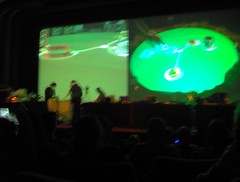
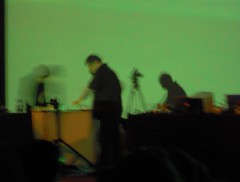
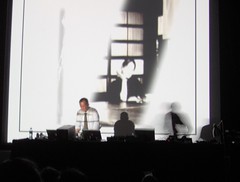
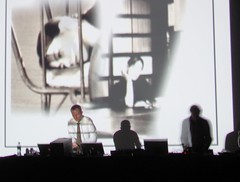
Headliner:Optronica Lab - Rechenzentrum
Support: Reactable, Ultre + Flate E, Vitascope
Venue:National Film Theatre, London, 16th March 2007
Optronica is a 5 day festival celebrating the combination of visuals with music. The lab took place in NFT screen 1 on the Friday evening. Four live performances, with accompanying visuals on the big cinema screen.
The first performance was by Glasgow’s Vitascope, a quirky blend of electronica and animation. Each piece of his sound was represented by a graphic, combining to give an abstract piece of animation, like some of the jazzy animations from the past. Low fi imagery which was fun to follow, tracking audio and visual patterns as they unfolded.
The next performance was by brothers Ultre and Flat-E from Sheffield, who have been a part of the Warp scene over the years. One provided sound, sampling scrapes and notes from a home made single string bowed instrument, laying it up, combining it with vocal sounds, into a dense noise scape. At times adding beats to make it more accessible and Warpy sounding. The other brother mixed in visuals, heavy on a sheep skull and bones, before switching to city scapes, touring buildings and night lights, before finally switching to crisp mechanisms, little things ticking away, gears and triggers.
The third performance was by a Spanish duo, Reactable, and was the most technical of the evening. Coming from a Spanish university, the pair had developed a table top solid object based music system which simulated the kind of techniques found in many music software systems. With a high resolution camera beneath the table top, each object they placed on top of the table had a set of parameters that could be manipulated by touch and movement. These affected the sound that the audience could hear, and the visuals that were translated onto the big screen. At times the sound was patchy, as the pair moved things about till they got the effect they were going for. But it was fascinating to watch, to see instruments and effects built up and manipulated and shifted.
The headliners were the Berlin electronica duo Rechenzentrum. However there was a delay in the start of their set as technical difficulties finally kicked in. Which was filled with a Q&A session with Reactable discussing how they had put together their piece, followed by a similar discussion with one of the Ultre/Flat-E brothers. Finally Rechenzentrum were ready to go, their downbeat easy going electronica mixed with pre-composed black and white and moody visuals. After some of the clever sets that had gone before, this seemed a bit contrived at times, just as though we were watching something that had been pre-recorded. Still the set was pleasant enough, though we did end up leaving early as things ran so late.
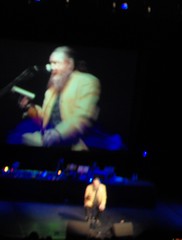
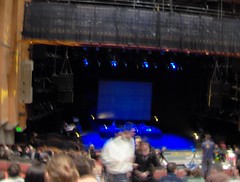
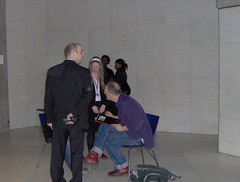
Headliner:Coldcut - A Tribute To Robert Anton Wilson
Support: Alan Moore, Bill Drummond, Ken Williams, Mixmaster Morris
Venue:Queen Elizabeth Hall, London, 18th March 2007
Robert Anton Wilson was the author of 35 books, and died in January of this year. Coldcut when approached to contribute to the annual Ether festival at the Queen Elizabeth Hall in London suggested that perhaps a tribute to the author would be appropriate.
The same night there was a beat boxing championship going on as part of the same festival. Arriving at 7.15 to meet in the bar for 7.45 start, it was a little odd wading through people making funny noises and being warned that we might be filmed for the DVD.
The night was in two halves. Throughout the two members of Coldcut provided music, while Mixmaster Morris seemed to be providing the visuals. Ken Campbell started the night, talking about his attempts to adapt the Illuminati trilogy as a play on stage. How this coincided with the murder of Robert Anton Wilson’s daughter in the mid-seventies, and the despair that Wilson fell into around that time. Suggesting that by bringing Wilson over to see the premier of the play actually saved his life, because it gave him the spark to start creating again. From there we had several sections of music, mixing with footage of Wilson and influences, heavy with his voice. Talking about his work, the perception of him as a science fiction writer, then as a new age writer, then as a philosopher, moving on to conspiracies, and drugs, and ways to rewire the mind. Through the night we had these sections, where we got an insight into who Wilson was, often at the expense of Coldcut, whose music kind of ended up being background material as I focussed on the words.
The second guest of the night was Bill Drummond, most well known for his work as part of the KLF and numerous projects that spun out over the years. When Drummond was 23 years old, he had done some set design, and Campbell recruited him for his play, giving Drummond the book to read and work with. Over the years the Illuminati trilogy has been an unconscious influence on Drummonds work, even if Wilson himself wasn’t specifically. Drummond rambled more than the other guests, kind of making you wonder why he was there. Though he did say he felt guilty, when Wilson’s friends appealed for money before his death Drummond was unimpressed, so he felt strange to then be asked to take part of the tribute night. Bumping his appearance fee, Drummond announced that he would be in the foyer at the end of the night, taking suggestions of things he could do with that money which would be a fitting tribute to Robert Anton Wilson. With a couple of chairs ready, he plonked himself square in the middle of the exit area, much to the annoyance of venue staff, who were encouraging him to move as we passed.
In the second half of the night, the final guest was author Alan Moore. He came on at first and read an extract from one of Wilson’s short stories, about four famous figures all together in a pub, dosed up on ecstasy and experiencing a joint hallucination of the end of the world - a heady piece, especially sigh Moore’s droll narration. More music and video from Coldcut and Mixmaster Morris, before Moore returned again. The second time Moore read us his own piece, a potted history of Wilson’s life, recapping all the material we had been through over the course of the evening. The piece was reminiscent of Moore’s spoken material, like Angel Passage and Highbury Working. Which for me was the highlight of the night.

Title:The Tripper
Cast: Lukas Haas, Jaime King, Jason Mewes, Marsha Thomason, David Arquette, Richmond Arquette, Paz de la Huerta, Ben Gardiner, Balthazar Getty
Director:David Arquette
The second Glasgow Fright Fest within the Glasgow Film Festival was started with the World Premiere of David Arquette’s directorial debut The Tripper. Though for such an occasion it would have been nice if the film company had seen fit to supply a copy of the film which didn’t flash up “This is the property of” every 10 minutes.
In the beginning Ronald Reagan has come to power, there are hippies protesting about logging, and one man desperately tries to just do his job so that he can get paid and buy medicine for his sick wife. Tragedy however strikes and his family is torn apart. Years later and its the present day, and the same woods, but new hippies. A dodgy love and drugs festival has been forced to move on after an incident the previous year and take up residence in these remote red wood forests. A group of friends travel to the festival in van, though one of the girl’s isn’t just paranoid because of the drugs, rather her psycho stalker ex won’t stop trying to call her. Along the way they have a run in with a group of local red necks, leading to violence. Thus, as the festival starts, and the bodies pile up, we have a selection of suspects. But just who is the madman in the Ronald Reagan mask swinging his axe?
Arquette himself appears as one of the red necks that the group of friends runs up against, and his (ex?) wife Courteney Cox is apparently in there as well, though I have to admit I have no recollection of her at all. Jaime King stars as Samantha the girl with the psycho ex, while Marsha Thomason provides the best friend part. Lukas Haas is Samantha’s sensitive but stoned new boyfriend, and Jason Mewes is just typecast.
The Tripper has its moments. There is certainly some humour in the masked ex-president. But overall its just kind of average really.

Title:S&man
Cast: Carol J. Clover, Debbie D, Erik Marcisak, Fred Vogel, Bill Zebub
Director:J.T. Petty
JT Petty has directed a couple of horror films. Interested in the nature of horror, of voyeurism, and how these things make people feel he decided to make a documentary. In particular he decided to make a documentary about a peeping tom who was caught in his home town. After securing funding and starting film Petty was then surprised to find that the peeping tom in question didn’t actually want to have anything to do with his film. The documentary starts on that basis, and continues as Petty flounders in his attempts to find something else to make a film about instead.
So his next stop is a convention for underground horror fans. There he meets directors, actresses and fans of low budget and fantasy fulfilment horror films. Some of which are particularly borderline, which is where he was particularly interested. Along the way he meets a director who makes home made films under the title “S&Man” (sandman). Each new episode has the same basis, the director finds a girl, and follows her, filming her all the time. After stalking her for a while he will then find someway to get close to her and kill her. Are these the documentation of serial killings or imitation snuff movies?
There is something unpleasant about watching S&Man, mixed in with commentaries by experts and colourful characters, it’s the S&Man material that we keep coming back to. Through the film Petty tries to get the film maker to explain what he is doing, to explain his techniques, to let him talk to his “actresses”, but he is evasive, and increasingly hostile. The film has a strong level of ambiguity - is what we are seeing real? Are these real murders? Are these even real films? Even the conclusion that Petty provides leaves doubt, and while there is no real desire to see the film again, there is that slight wish that you could rewind the last 5 minutes and make sure you catch what he says about what his goals were and what he has done to meet them.
If you look at IMDB there is a list of people who appear in the film - Carol J Clover, Debbie D, Bill Zebub, and Fred Vogel. All listed as “himself” or “herself”, as you would expect for a documentary. However, the telling part is Eric Rost, the maker of the S&Man DVDs, who is listed as being played by Erik Marcisak. So it becomes clear, Petty has manipulated the viewer into thinking something was real, to explore the emotions involved. Or perhaps having committed to delivering a film he felt that he was forced to make something up to meet his obligations? Regardless, the result of this contribution to the second Glasgow Fright Fest was discomfort, and the film didn’t particularly go down well with the audience. But to a degree that was the point.
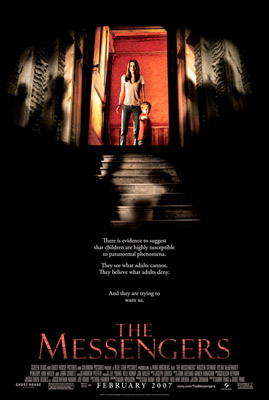
Title:The Messengers
Cast: Kristen Stewart, Dylan McDermott, Penelope Ann Miller, John Corbett, Evan Turner, Theodore Turner
Director:Oxide Pang Chun/Danny Pang
After teen Jess (Kristen Stewart) has got herself into trouble that has shaken up the entire family, she is not allowed to forget it. With the resultant financial problems, her father Roy (Dylan McDermott) decides that the best thing to restore the family’s flagging fortunes is to buy the most obviously haunted house in the middle of nowhere that he can find. Having picked a run down sunflower farm, Roy, Jess, the mother Denise (Penelope Ann Miller) and the mute younger brother Ben (Evan Turner) all make the big move. But as Ben watches things move around that no one else can see, things start to bleed into Jess’s reality, deeply horrific things. Of course, having been the bad girl, no one believes her, and while her brother can see them better than she can, he doesn’t speak.
The Messengers is one of those horror films which is a bit of this and a bit of that. Flocks of crows hang around the house in malevolent fashion like a version of The Birds. The house and the lingering influence of the past takes on the feel of The Amityville Horror. The elements are all combined and put through contemporary twists, that give it a more modern and Asian feel. Which isn’t entirely surprising, given that it is the American debut of Hong Kong directors the Pang Brothers. For me The Eye is one of the creepiest films I have ever seen, and I’ve yet to find a film by the Pang Brothers disappointing.
The vocal crowd from the London Fright Fest visiting the Glasgow Film Fest seemed to find The Messengers disappointing . Perhaps because it was the lowest rated film of the day’s films, with the lowest blood and gore content? But for my money, it was the only film in the selection of 5 that I have actually found gave me chills. Not up to the standard of The Eye, but certainly little shivers went up as dead things crawled along the walls.
Trailers for this film have now started showing in the UK, they are horrible, and should be avoided if possible. There is too much of a trend in trailers to show too much, to strip scenes of suspense and context, so that by the time that you see the film it all feels lacklustre. I am glad I saw it blind.
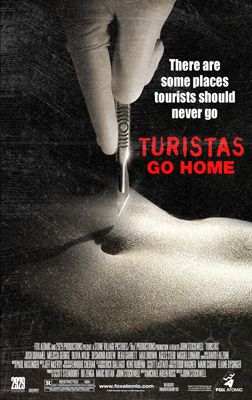
Title:Turistas
Cast: Josh Duhamel, Melissa George, Olivia Wilde, Desmond Askew, Beau Garrett, Max Brown, Agles Steib, Miguel Lunardi
Director:John Stockwell
A bus hurtles along precarious country roads in Brazil, full of locals and a handful of daring tourists. Taking a corner too fast, the bus loses the road, and crashes, the passengers, desperately climbing out, before it goes tumbling down the hillside. Sat by the road side a couple of English guys hit on a couple of American girls, the brother of one of the girls distracted by an Australian girl. Given the choice of sitting by the roadside for a replacement bus, or following the trail down to the beach bar, the group go for the bar. There they drink, they dance, and while the English guys fail to make headway with the American girls, they are a big hit with the locals. But when the group wake up groggy in the morning, its clear they have been drugged, and all their money and belongings have been taken. However its only after that, that things really start to get nasty.
Turistas was shown as part of the Glasgow Film Festival’s Fright Fest, and will apparently open in the UK in the summer of this year. Though when it does it will do so under the name Paradise Lost, one of those foolish name changes that some people thing have to be made to make a film work better for the market. In some ways Turistas works to the clichés of the tourist slashers, like Hostel - group of spoilt kids hit deepest darkest where ever and bad things happen. Turistas has the benefit of being pretty and shiny, and the underwater cavern scenes are particularly striking and memorable.
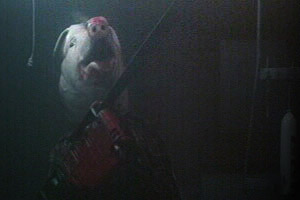
Title:Motel Hell
Cast: Rory Calhoun, Paul Linke, Nancy Parsons, Nina Axelrod
Director:Kevin Connor
While the opening film of the Glasgow Fright Fest, Trippers, might have working off the influence of 80’s horror, Motel Hell which finished the festival was a new print of a little seen 80’s horror. Farmer Vincent runs Motel Hello in a small town, the “O” of hello blinks out leaving the sign saying “Motel Hell”, but visitors still come. Farmer Vincent is also well known for his smoked meat, which are popular throughout the state. What is Vincent’s secret? Well, obviously he kills people! Goes out every night and lays traps for them, and does bad things to them. Though things are complicated when one of the survivors of an accident caused by Vincent is blonde and attractive, and instead of killing her, he takes her into the family home, and of course, its only a matter of time before she finds out the truth. Motel Hell is a somewhat tongue in cheek horror film. Black and bleak, but naughty with it. The element of the absurd that runs through it, culminating in a chainsaw duel, makes it clear that there are laughs to be had here.
Thursday, March 01, 2007
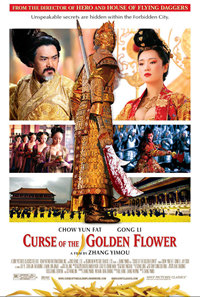
Title:Curse Of The Golden Flower (Man cheng jin dai huang jin jia)
Cast: Yun-Fat Chow, Li Gong, Jay Chou, Ye Liu, Dahong Ni, Junjie Qin, Man Li, Jin Chen
Director:Yimou Zhang
Sunday night the 3rd annual Glasgow Film Festival was finished with the UK premiere of The Curse Of The Golden Flower. Golden Flower is the new film by director Zhang Yimou, Zhang has been directing for years, though he really raised his profile with Hero and House of Flying Daggers. Golden Flower is a lot like those films, though with less martial arts and bigger set pieces, and much more use of colour.
To a degree this is a court drama - the Emperor feeds the Empress medicine, and she knows that it has just changed, with some investigation she discovers the new ingredient is a poison. She can't refuse to take the medicine, but she can form plots of her own. Caught between the Emperor and Empress are their three sons, the oldest of which comes from a previous marriage and has been involved with the Empress, while the second son has just returned from war. All a set up for betrayal and rebellion. Weakness, jealousy, and lust all add their tint to the rainbow palette.
The Curse Of The Golden Flower feels different than Zhang’s last few films. Perhaps because the bulk of the film all takes place within the same place? Perhaps because is feels more constrained and claustrophobic in some ways? Chow Yun Fat as the Emperor and Gong Li as Empress take up the core of the film and radiate a veiled malice towards each other. While Zhang seems to be specializing in the tragedy with his last few films, I felt more wrung out and edging on depression as Golden Flower reached its climax than before.
 this is the voice of re:mote induction.
this is the voice of re:mote induction.